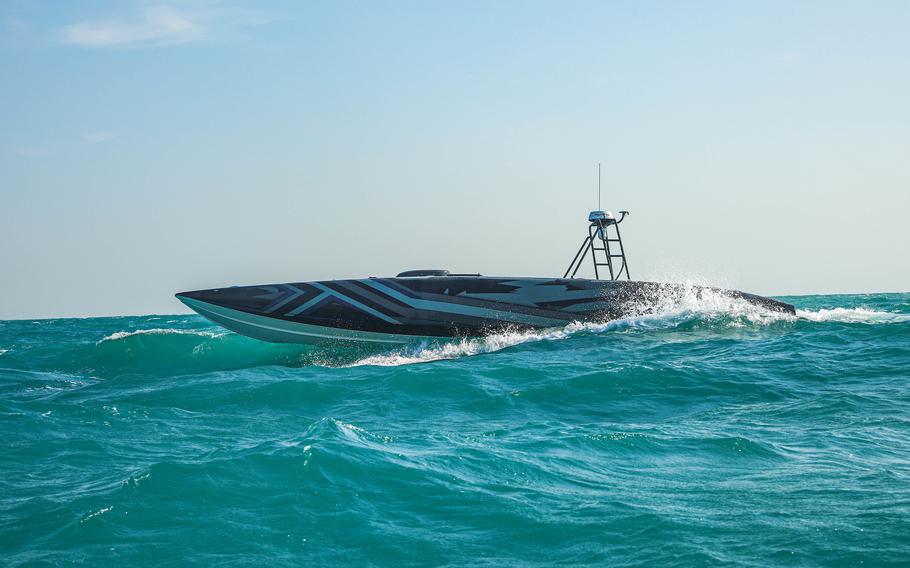
A T-38 unmanned surface vessel operates in the Arabian Gulf, Dec. 4, 2021. (David Resnick/U.S. Navy)
The United States is arming the Philippines with advanced sea drones as part of an effort to bolster an ally threatened by China’s territorial claims and growing maritime power.
The state-run Philippine News Agency published a photograph Wednesday of Defense Secretary Lloyd Austin checking out a T-12 Mantas unmanned surface vessel a day earlier in Puerto Princessa on the country’s western island of Palawan.
Manila has been in a standoff with Beijing’s coast guard and maritime militia over disputed South China Sea territory west of Palawan.
The Philippine navy has four T-12s along with another type of sea drone — the T-38 Devil Ray — Marine Capt. Joshua Estrada, a liaison officer at the U.S. Embassy in Manila, said by email Friday.
More unmanned vessels will be provided to the Philippines, Austin said at the Western Command headquarters on Palawan, according to the news agency.
“We expect to see many more platforms like [the T-12] delivered with the $500 million in [foreign military financing] that I announced during my visit in July, to help ensure that the Philippines has the capabilities and means to defend its rights and its sovereignty throughout its exclusive economic zone,” he said in the agency’s report.
Austin didn’t say how many additional sea drones the U.S. will provide or how much each of the vessels cost.
The United Kingdom in January 2020 agreed to buy five T-12s, along with sensors, equipment, spare parts, training and technical support for about $2.3 million, Naval News reported at the time.
Austin watched a drone boat in action off Palawan’s coast, according to the news agency’s report.
“When the T-12 was on display out there … a fundamental part of that is the ability to command and control that using cyber capabilities,” he said.
The electric-powered T-12 is 12 feet long and can carry a 140-pound payload and launch from ship or shore, according to Florida-based manufacturer Martac.
“The T12 has the capability of long duty cycles performing the dull, dirty and dangerous missions,” the company’s website states, listing missions such as mine countermeasure, search and rescue, security, swarming, and electronic warfare and intelligence.
Ukrainian drone boats and missiles have inflicted heavy damage on Russia’s Black Sea fleet since late 2022, and that success has caught the eye of U.S. officials.
Deploying large numbers of cheap drones into a relatively confined battle space such as the Taiwan Strait or the seas near China could make those spaces no-go territory or escalate the costs of operating there to prohibitive levels, said James Holmes, chair of the maritime strategy program at the Naval War College in Newport, R.I.
The Pentagon’s Replicator program, announced last year, envisions such a capability, he told Stars and Stripes for an April 12 report.
“If the Joint Force, along with our allies, can seal off the straits along the first island chain, it will have corralled China’s navy and air force and can strike at them with missiles and drones within their own home waters,” Holmes said. “That’s a wicked problem for Beijing.”
But former Navy Capt. Jan van Tol, a senior fellow at the Center for Strategic and Budgetary Assessments, a nonprofit defense-policy think tank in Washington, D.C., said Russian electronic warfare and physical barriers have reduced the effectiveness of Ukrainian sea drones.
However, the unmanned vessels could be effective in narrow straits and other geographically constrained areas, he said by email Friday.
“Where the ranges are comparatively small, smaller and cheaper kinds of drones could have significant effects in that a comparatively large number of them could overwhelm target defenses, cover significant portions of the anticipated maritime battlespace and, importantly, influence an enemy’s risk calculus,” he wrote.